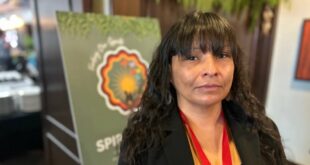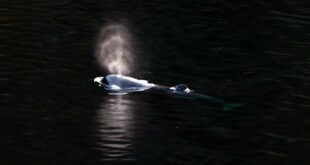From the n ̓x̌ax̌aitkʷ to the Shuswaggi, sightings and speculation around the unknown continue

Travel to a popular lake in British Columbia, and chances are you'll encounter a beach, some boats — and a tale about some sort of unidentified creature that lurks beneath the surface.
"When we talk about water, there's an inherent mystery to it. I think it's because we don't understand the full potential and power of water in and of itself," says Westbank First Nation Coun. Jordan Coble.
He's one of the members of his community entrusted with telling the story of the n ̓x̌ax̌aitkʷ, also known as Ogopogo, the serpent-like creature that is perhaps B.C.'s best-known lake monster.
"It intrigues people. It inspires people to be more mindful," Coble said.
As well as the n ̓x̌ax̌aitkʷ in Okanagan Lake, there's the tale of the Shuswaggi in Shuswap Lake. At Sproat Lake, a sign says some of the historic petroglyphs carved into the rock faces could represent mythical sea serpents.
Meanwhile, around Harrison Lake, a cottage industry has long centred around the legendary Sasquatch.
WATCH | A look at the Indigenous and geological history of Sproat Lake:

Exploring the Indigenous history of Klee-koot, a.k.a. Sproat, Lake
In celebration of Sproat Lake and its surroundings, we took a deeper look at the people who have called the area home for generations. Wawmeesh Hamilton tells us about the Indigenous residents who celebrate their heritage and connection with the lake and the region they call Klee-koot.
So what is it about lakes in this province — more so than rivers, oceans, mountains or forests — that inspire such stories?
'We've always had fertile imaginations'
John Kirk, president of the British Columbia Scientific Cryptozoology Club, has a theory.
"As human beings throughout the ages, we've always had fertile imaginations when it comes to places that are inaccessible, like the deepest parts of a lake," he said.
Kirk has been studying lake cryptids — creatures that have been sighted but whose existence has never been proven by science — since 1987. He says B.C.'s abundance of deep lakes surrounded by forests provides an environment where all sorts of creatures can thrive but where people might only get a glimpse of what it actually is.
"You might think it's a sturgeon, an oversized brown or rainbow trout, maybe a bunch of them swimming in the line, maybe a group of otters swimming in line. You go to the logical [explanations] first," he said.
"When you've eliminated all of them, what are you left with? You're left with the mystery. And that mystery is the thing that has kept us going."
While he's passionate about the topic, Kirk cautions people from thinking there is an abundance of undiscovered creatures out there. There have been sightings of unidentified creatures at 42 different B.C. lakes, he said, but further research into such claims hasn't proved anything conclusive.
"Evidence-gathering is extremely difficult because they're the most elusive creatures that ever existed," he said.
"There's no cessation of this until we actually find out what it is out there, and I'll probably be doing this for the rest of my life."
'It's a law we have to respect'
Whether lake lore becomes part of the paranormal or is simply used for tourism purposes, Coble wants people to remember the tale of the n ̓x̌ax̌aitkʷ centres around the creature revealing itself as a spirit, one meant to remind people of the need to protect the lake.
"It's more than just a being or an entity … it's a law that we have to respect, and it refers to just being mindful of our responsibilities to protect water for all walks of life, human and animal alike," he said.
"We have to … live in reciprocity, to make sure that we do our best to protect the good things that are in the water and fend off the things that aren't."
The question of agency and ownership over lake stories was thrust into the public conversation two years ago when the City of Vernon transferred the copyright of the name "Ogopogo" to the Sylix Nation.
Coble believes it's an opportunity for Indigenous people to reclaim how these stories are told in ways that centre the values of their communities.
At the same time, he knows that so long as there are lakes, there will always be sightings that can't be fully explained — and people's imaginations will always run wild.
"There's a bit of a sensationalism, for sure, within modern media … but at the same time, we've had stories about large creatures in and off the water for hundreds of years," he said.
"It's everyone's right to tell stories, and we have to be creative and critical as to how we understand them … but at the same time, sometimes it's just good to hear a good old-fashioned tall tale and just be in a moment."
ABOUT THE AUTHOR
@j_mcelroy
Justin is the Municipal Affairs Reporter for CBC Vancouver, covering local political stories throughout British Columbia.
*****
Credit belongs to : www.cbc.ca
 MaharlikaNews | Canada Leading Online Filipino Newspaper Portal The No. 1 most engaged information website for Filipino – Canadian in Canada. MaharlikaNews.com received almost a quarter a million visitors in 2020.
MaharlikaNews | Canada Leading Online Filipino Newspaper Portal The No. 1 most engaged information website for Filipino – Canadian in Canada. MaharlikaNews.com received almost a quarter a million visitors in 2020.







